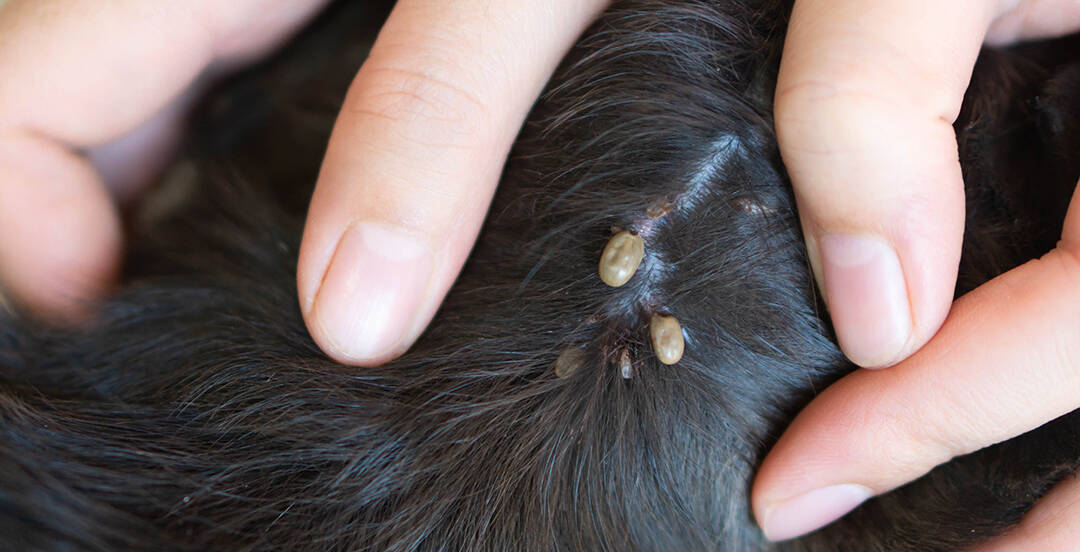With over 800 species worldwide and at least 15 species found in North America alone, ticks are indeed a cause for concern. Finding one on your Doodle dog is never a pleasant experience and in fact, can be downright creepy.
No need to panic though, finding and removing ticks is not that difficult if you know what to do.
How do you find and remove ticks from Goldendoodles, Labradoodles, and other Doodle dogs? Carefully run your hands through the entire coat, feeling on the skin for any foreign bumps. Check warm, hidden areas such as between the toes, around the ears, under their arms, and around their legs. To remove a tick, use tweezers to grasp it at skin level and pull up firmly yet gently.
Tick Removal and Prevention Guide
- Removal Tool: if you have a tick to remove or want to prepare for the future, get the Tick Key on Amazon.
- Tick Repellant Collar: we recommend these tick collars — they’re a favorite of dog owners all over.
- Topical Tick Prevention: we recommend this as the best topical tick prevention
- Oral Tick Prevention: this is what I give my Doodle, Oliver, each month. It’s small and he chews it right up.
We’ll be covering the step-by-step process for removing a tick that embedded itself in your Doodle, along with tick seasonal activity, hazards, and behavior. If this topic ticks you off like it does me, you’ll keep reading.
Tick Seasons and the Dangers of Ticks to Dogs
Ticks are not only nasty to think about, but they also can carry and transmit various diseases to dogs and people. Goldendoodles, Labradoodles, and other Doodle dogs tend to have beautiful, thick fur which can provide an ideal cover for ticks, making them difficult to spot.
When to Be on the Lookout
The various species of ticks and their three growth stages, larva, nymph, and adult, all have different periods of high activity. Broadly speaking, ticks can be active any time that the temperature is above freezing, though activity usually peaks in the late spring and early fall.
The Dangers Ticks Present
Unfortunately, ticks can transmit many harmful diseases to your sweet Doodle. The black-legged ticks (A.K.A. deer ticks) spread the dreaded Lyme disease. Both the American dog tick and wood tick are responsible for transmitting Rocky Mountain spotted fever.
Other diseases spread by ticks include ehrlichiosis, anaplasmosis, tularemia, and the Powassan virus, all of which can make your dog very sick. While you can’t catch any of these diseases from your dog, an infected tick can just as easily bite and infect you or your family.
Where Do Ticks Go on Dogs?
In a process known as questing, a tick climbs 1 – 2 feet up foliage and waits patiently on a leaf tip for a potential host to stroll by. When an unsuspecting host comes along, the tick quickly climbs aboard.
Once on the host, a tick will usually crawl to a warm, secluded spot. On dogs, this is often around the ears, genital area, “armpits,” base of tail, or feet, so these are places you will want to closely examine.
If you live in an area where ticks are common and your Doodle is not on tick prevention, carefully check for ticks after each venture outdoors.
Begin by running your fingers through your dog’s fur, being sure to reach all the way to the skin. Feel for any small bumps (some species are very small). Check the above-mentioned places carefully, especially between the dog’s toes.
I was on a hike with my Labradoodle, Oliver, this past weekend. We got into some thick brush. When we got to the car, I was picking sticks from his fur and came across a ton of burrs (or stickers — more on those in this article) that’d tangled in his fur. Later that afternoon, I found a tick on the underside of his ear as I was brushing him out. It was down-right creepy! I decided to check him again before bed and as I was giving him my tick inspection rubdown, ended up finding ANOTHER tick under his armpit.
We live in the Midwest, where ticks are all too common. Luckily, I have him on a monthly flea/tick prevention regimen that seemed to keep them from burrowing into the skin. I recommend using a comb like this one after any outdoor activities where ticks may be. It can help get any out that haven’t yet attached themselves and allows you to give them a good check.
Do Ticks Burrow Completely Under the Skin?
A tick does not burrow its entire body under the skin; just its mouthparts. Its mouth has one chainsaw-looking piece called a hypostome with barbs on three sides and a central groove through which saliva flows one way and blood the other.
A tick’s other mouthparts consist of a pair of chelicerae which work to anchor the tick in place and enable it to drive its barbed hypostome deep into the skin. Once attached, a tick can remain on its host for up to 12 days, happily feeding while becoming engorged with blood.
Video of a Tick Latching on to a Host
Male ticks don’t feed nearly as long as females do. After feeding, a male will mate with one or two females and then will usually soon die.
The females will continue to feed after mating until they are literally about to pop. They fall to the ground where they will lay anywhere from 3,000 – 6,000 eggs and die shortly after. That is a lot of future ticks! This is why ticks are so prevalent in certain areas.
How Do You Remove an Embedded Tick From a Dog?
If you locate a tick that has already attached itself to your poor Doodle, complete the following steps to safely and effectively remove the nasty little creature.
- Wear gloves.
- With a pair of tweezers, grasp the tick firmly at skin level without crushing or twisting it.
- Smoothly pull straight up to remove. To reduce the possibility of the head detaching from the body, do not twist or use jerking motions.
- Dispose of the tick in a sealed plastic bag, or simply flush it down the toilet.
- Thoroughly cleanse the bite area with soap and water, and gently pat dry.
- Apply antibiotic cream as a precaution. This will not prevent a disease from taking root, but it will prevent an infection from developing.
- Wash hands well.
Tick Removal Tools: There are specially designed tick removal tools like the Tick Twister and Tick Keys (both on Amazon). These can be used in place of tweezers and were specifically designed for the job. If you live in a part of the country where ticks are especially prevalent, it might be wise to keep one of these with you on each outdoor adventure with your Doodle.
What Is the Best Tick Prevention for Doodles?
Keeping your Doodle tick-free is important not only for his health and well-being but also for the safety of you and your family. Thanks to the wonders of science, keeping ticks off of your dog has never been easier.
When it comes to tick prevention, you have quite a few options. The best tick prevention is a multipurpose one that protects against pests common to your area and fits your budget. Talk with your veterinarian about the pros and cons of each option and possible side effects or drug interactions.
Collars
Simply placed on the dog’s neck, collars are perhaps the easiest solution. Length of protection varies between brands, but the ones we’ve listed here protect against both fleas and ticks. All are available on Amazon.
Our Pick is Seresto – 8 month of protection and most popular option among dog owners.
- Pet Armor – 6 month protection.
- Hartz UltraGuard Plus – 7 month protection.
- Adams – 7-month protection.
- Arava Botanical – 5 months of all-natural protection.
Topical
Topical applications are administered directly on the dog’s skin between the shoulder blades. The ingredients are absorbed through the skin, circulated through the bloodstream and stored in the oil glands of the skin. Most offer 4 weeks of protection before they must be reapplied.
Here are some of the most popular and the parasites they protect against (all available on Amazon).
Our Pick is Frontline Plus – Protects against fleas, ticks, and chewing lice and is the most popular choice of dog owners.
- K9 Advantix II – fleas, ticks, and mosquitoes.
- Virbac Effitix – fleas, ticks, mosquitoes, and lice.
- Adam’s Plus – fleas, ticks, and mosquitoes.
- Vectra 3D – fleas, ticks, mosquitoes, biting flies, and mites.
Oral
Tick prevention that can be given by mouth has unique advantages. You don’t need to worry about accidentally coming in contact with chemicals when petting your dog as you might with a collar or topical option, and they are easy to administer.
Here are three chewables that guard against both fleas and ticks.
Our Pick is Simparica – It offers 1 month of protection (monthly doses) and is what I personally have my Labradoodle on. He chews them right up, no problem.
Other Options
Easy Defense is a tag that attaches to your dog’s collar and naturally repels fleas, ticks, and mosquitoes by using programmed frequencies to deter pests without any chemicals at all.
Ticks don’t care for essential oils, some of which are safe to use on dogs. Try adding 30 drops of lavender, cedar, grapefruit, eucalyptus, rosemary, or lemongrass essential oil to one cup of water and spray onto your Doodle’s fur.
Geranium and rose geranium essential oils are highly esteemed for their tick repellent properties and are gentle enough to be applied directly to your dog’s shoulder blades and base of tail to repel pests like ticks.
You can learn more about dog tick removal by watching “How To Take A Tick Off Your Dog – Professional Dog Training Tips” down below:





